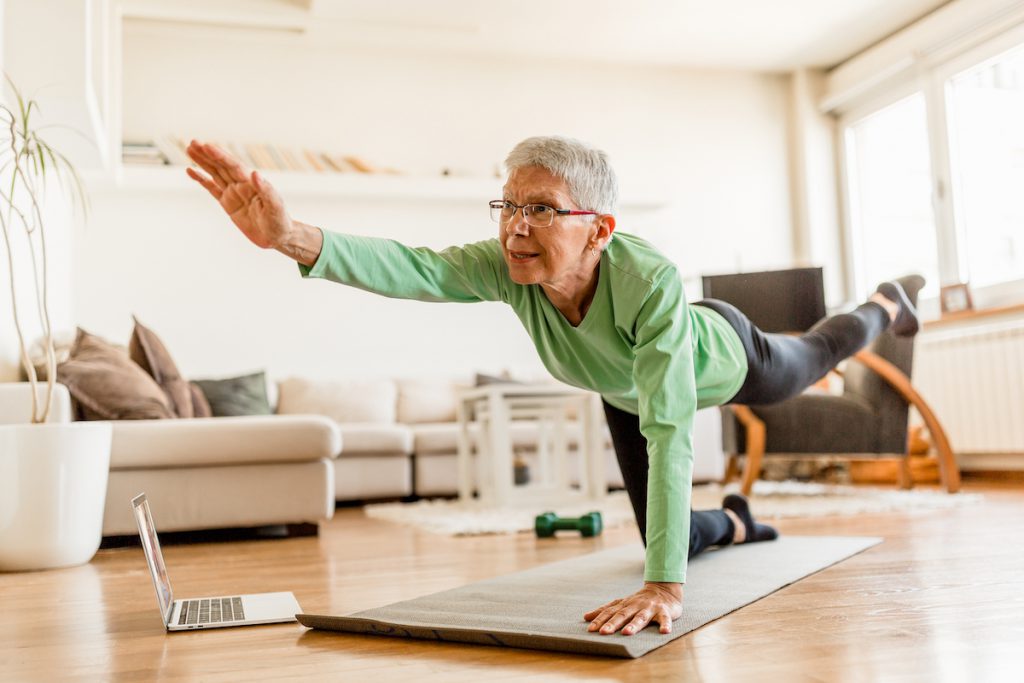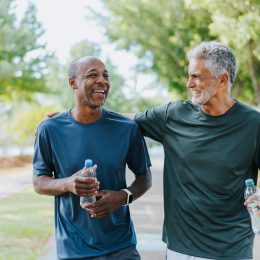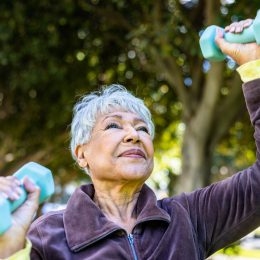5 Top Questions About Age-Related Muscle Loss, Answered
Adults naturally lose muscle mass as they age. But that doesn’t mean you can’t wage a fair fight against it. Here’s how.

We’re all pretty clear on what muscles are, but you may not be as familiar with the related word “sarcopenia.” It describes a phenomenon that’s quite common after age 65: an accelerated loss of muscle mass, strength, and function. In fact, the National Institute on Aging says sarcopenia affects about 30% of people aged 70 and older.
Eventually, weaker, smaller muscles make independent living more challenging. Less strength and power slow your walking speed and throw off your balance. Daily activities like getting out of a chair or up off the floor no longer feel like a given.
But aging doesn’t have to be a one-way march toward immobility. It is possible to slow down or prevent sarcopenia, so you can continue to maintain your independence and enjoy your life to the fullest.
Keep your muscles strong with SilverSneakers! Classes and events are happening right now at participating gyms, online through SilverSneakers LIVE, and at community centers near you. Activate your free online account to get started.
What causes sarcopenia, or age-related muscle loss?
The passing of time is the culprit. Experts say that our bodies are strongest during our 20s and 30s. Then, if we don’t take corrective action, our muscle size, strength, and power start to wither away. Initially, these changes unfold so slowly that we don’t notice it. As the decades pass, however, the losses accelerate. By age 80, many of us will have lost as much as a third of our original muscle mass.
Why does this happen?
In part, muscle is a use-it-or-lose-it tissue — and most of us move less as we get older. But that’s not the whole story, explains Stuart Phillips, Ph.D., a professor in the department of kinesiology at McMaster University who has extensively studied sarcopenia.
Even folks who regularly hit the gym will likely lose some strength over time, Phillips says. That’s because, as we age, our muscles become less responsive to strength training, a phenomenon technically known as anabolic resistance.
Though Phillips and other researchers are still learning more about age-related anabolic resistance, he says several factors likely play a role. As we age…
- Inflammation increases, which can damage our DNA.
- The energy production centers of our cells (called mitochondria) don’t work as effectively.
- Cells also lose the capacity to divide. Instead of dying, these damaged cells release harmful chemicals.
“All of those probably contribute to why older skeletal muscle is not as responsive to anabolic stimuli as younger muscle,” says Phillips.
Recommended reading: 4 Ways to Fight Muscle Loss and Win
How is sarcopenia diagnosed?
Your physician or physical therapist will likely give you some tests to measure your strength and power. Among these is a sit-to-stand test, says Cara Dobbertin, P.T., D.P.T., the founder of Practitionr, a healthcare provider website.
A variation of this test measures how long it takes you to do five sit-to-stands, she says. Your doctor might also do an MRI or DXA scan to assess your muscle quality.
Press play to try the Sit-to-Stand Test and learn more about it here.
What are the health risks of sarcopenia?
There are many of them, and they can snowball. When you’re weaker, it’s harder to stay balanced, which makes tripping and falling more likely. On top of that, without muscle tissue to cushion your bones, that fall is more likely to result in a fracture.
Then, if you’re confined to a bed as that fracture heals, sarcopenia will rapidly accelerate. Three weeks of bed rest, for example, ages your muscles by roughly 30 years, according to a 2022 report in the Annual Review of Medicine. That means, upon discharge, your risk of falling again and experiencing more fractures will be even higher.
In addition to increasing your chances of breaking a bone, sarcopenia can also:
- Boost your risk of heart disease and diabetes. That’s because muscle tissue plays a crucial role in keeping inflammation and insulin resistance in check.
- Make it harder to survive cancer and other diseases that tend to result in a marked loss of body weight.
- Interfere with cognitive function. A study of more than 8,000 people determined that older adults with less muscle mass were more likely to struggle with planning, decision-making, and other executive functioning tasks.
- Accelerate fat gain. The less muscle you have, the slower your overall metabolism.
All of this tends to create a vicious cycle, says Phillips. As muscle mass shrinks, inflammation rises. The increased inflammation intensifies the anabolic resistance mentioned earlier, so muscle mass decreases even more.
What can I do to prevent sarcopenia?
This condition can be tamed with both exercise and dietary tweaks. Experts weigh in on the best strategies for each.
Strength Training
This is the lifestyle habit you definitely don’t want to skip. Strength training stresses and damages your muscles. Even if that sounds bad, it’s not. Between sessions, your body rebuilds that muscle tissue, making it stronger. That’s important because stronger muscles do more than allow you to go about your daily activities with ease. They also translate to improved heart, lung, and cognitive health.
If you’ve been diagnosed with sarcopenia, you’ll want to work with a trained professional, like a physical therapist, who can help you exercise safely, monitor your form, and modify exercises to work around limitations like knee pain or back pain, says Dobbertin.
You should try to follow these basic guidelines:
Aim for two weekly sessions. It’s the standard recommended amount for strength training. But if you can only strength train one day a week, you’ll likely still see results, says Phillips. Some strength training is better than none.
Focus on functional exercises. Think about the activities that you want to keep doing long into your 70s, 80s, and 90s, says Dobbertin. Walking and standing up from a seated position are a given. You probably also wouldn’t mind being able to descend your basement steps to get to the washing machine, carry your groceries in from the car, and use the toilet without assistance. To maintain your independence, Dobbertin recommends squats, balance exercises, heel-and-toe raises, and seated rows.
Recommended reading: Functional Fitness: The SilverSneakers Guide
Use light resistance. Going too heavy too soon will impact your ability to move around during the day, says Dobbertin. In the beginning, your body weight might be all you need.
From there, you can progress to using fitness bands or dumbbells for resistance. A side benefit of dumbbells: In addition to increasing the challenge of a squat or sit to stand, they’ll improve your grip strength, says Dobbertin.
A Protein-Rich Diet
Protein is essential because it helps repair and maintain muscle tissue. To combat sarcopenia, Phillips recommends eating 1.6 grams of protein per kilogram of body weight. For most people, that’s about 100 to 150 grams of protein a day.
Subscribe to our newsletter
It's quick and easy. You could be one of the 13 million people who are eligible.
Already a member? Click to discover our 15,000+ participating locations.
Follow Us
You can achieve that goal by consuming one to two protein-rich foods with each meal and snack, says Jordan Hill, M.C.D., R.D., lead registered dietitian at Top Nutrition Coaching.
Here’s the menu Hill suggests to reach 100 grams of protein over the course of a typical day. The exact protein grams may vary:
Breakfast: 3/4 cup cottage cheese, 1 cup cut fruit (18 grams of protein)
Snack: 1 banana, 2 tbsp peanut butter (8 grams of protein)
Lunch: Cobb salad with 1 hard-boiled egg and 3 oz diced chicken (30 grams of protein)
Snack: 1 cheese stick, small palm full of mixed nuts (12 grams of protein)
Dinner: 4 oz wild caught salmon, 1/2 cup rice, 2 cups sautéed veggies (30 grams of protein)
Recommended reading: 10 Ways to Sneak More Protein Into Your Diet
Supplements
Several supplements show promise in helping to address sarcopenia. It may go without saying, but you’ll want to talk to your doctor before taking these or any other supplements to learn how they interact with your medications.
You’ll also want to ask your healthcare provider about the recommended dosing and what to look for on the label. Remember, supplements aren’t regulated by the FDA the same way medicines are regulated, so it’s wise to keep your doctor in the loop.
- Creatine monohydrate. People aged 55 to 71 who took 3 to 5 grams of creatine a day increased their strength more than study participants who resistance trained but didn’t take the supplement, found an analysis of 10 studies on the topic. As a side benefit, creatine may also help improve bone mineral density and cognitive function.
- Omega 3 fatty acids. These supplements seem to counteract the inflammation that can make it harder to build and maintain muscle as you get older.
- Vitamin D. Vitamin D does more than help keep bones strong. It’s also involved in muscle strength. If you’re deficient — and many people older than 65 are — a supplement could be helpful, says Phillips.
Is it ever too late to improve muscle loss?
Definitely not. If you’ve already lost a considerable amount of strength, you might wonder, why bother doing anything about it now? But McDonald shares this encouraging advice: “It’s never too late for anything,” she says. “You can get stronger. All you have to do is try.”
Recommended FREE SilverSneakers On-Demand Class: Beginner Strength-Training Exercises for Seniors
You may also like:
- Beat Age-Related Muscle Loss: Your 5-Step Plan
- 5 Better Ways to Get Stronger, According to Physical Therapists
- Strength Training for Older Adults: The SilverSneakers Guide
- Healthy Eating for Older Adults: The SilverSneakers Guide
- Building Core Strength: The SilverSneakers Guide
- 4 Rules for Losing Fat, Not Muscle
See our sources:
- Sarcopenia definition: Age and Aging
- Muscle loss by age 80: Harvard Health Publishing
- Nutritional supplements for sarcopenia: Nutrients
- Strength training: National Institute on Aging
- Bed rest and muscle loss: Annual Review of Medicine
- Diabetes and sarcopenia: Diabetes, Metabolic Syndrome and Obesity
- Muscle mass and cognitive function: Geriatrics
- Sarcopenia and cancer: Journal of Clinical Oncology
- Creatine monohydrate: Medicine and Science in Sports and Exercise
Check Your SilverSneakers Eligibility Instantly
SilverSneakers members can go to thousands of nationwide gyms and fitness locations, plus take SilverSneakers LIVE online classes that are designed for all fitness levels and abilities. If you have a Medicare Advantage plan, it may include SilverSneakers — at no additional cost. Check your eligibility instantly here.
Already a member? Get your SilverSneakers member ID and exclusive fitness and wellness content by activating your online account here.
Not eligible for SilverSneakers? You can still get 200+ free SilverSneakers On-Demand videos and stay in touch with us by creating your online account.





